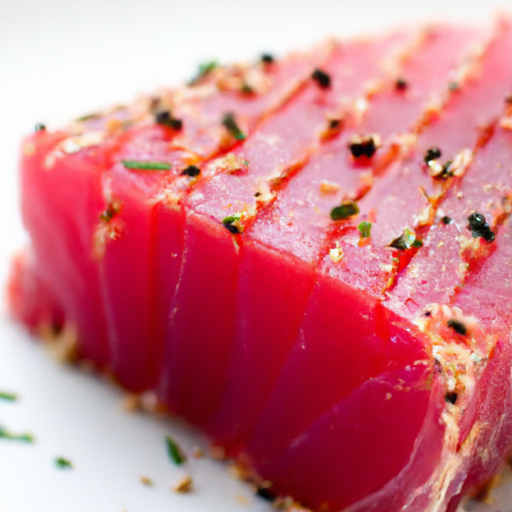Discover the Delight of Ahi Tuna Steaks: From Ocean to Plate
If you’re a seafood enthusiast looking for a culinary adventure, it’s time to set sail to the world of ahi tuna steaks. Renowned for their rich flavor, versatility, and impressive nutritional profile, ahi tuna steaks have become a beloved ingredient in kitchens all around the globe. So, grab your apron and prepare to be amazed by the wonders of this tantalizing fish.
Taste and Texture: A Match Made in Oceanic Heaven
Ahi tuna, also known as yellowfin tuna, boasts a distinct taste that sets it apart from other seafood. Its flesh offers a mild yet buttery flavor, often described as meaty and succulent. The meat has a lusciously firm and dense texture, making it a perfect candidate for various cooking methods, from grilling to searing.
Multitude of Culinary Uses
Given its exceptional flavor and texture, ahi tuna steaks can be prepared in a multitude of ways, providing an array of culinary delights. Here are a few popular methods to inspire your next kitchen adventure:
- Seared perfection: Sear the ahi tuna steaks quickly on high heat to achieve a beautifully browned exterior while keeping the center deliciously rare. Pair it with a refreshing salad or serve over a bed of fluffy rice for a delightful meal.
- Grilled greatness: Fire up the grill and bring out the smoky flavors of ahi tuna steaks. Marinate the steaks in your favorite spices and sauces, then cook them briefly on each side. This method adds a delightful char while maintaining the fish’s tender juiciness.
- Comforting ceviche: For a light and exquisite dish, slice the ahi tuna steaks into thin pieces and marinate them in citrus juice. The acidity of the juice will lightly “cook” the fish, leaving it fresh, tangy, and full of flavor. Add some chopped vegetables and herbs for an extra kick.
A Nutritional Powerhouse
Beyond its delectable taste and culinary versatility, ahi tuna steaks offer impressive nutritional benefits. Rich in protein and low in fat, these steaks are a dream come true for health-conscious foodies. Moreover, ahi tuna is an excellent source of omega-3 fatty acids, which are known for their heart-healthy properties. This fish is also packed with essential vitamins and minerals like vitamin B12, selenium, and niacin, contributing to a well-rounded diet.
Ahi Tuna Steaks: A Catch with a Fascinating Background
Ahi tuna is a species native to tropical and subtropical waters, making it a prized catch for seasoned fishermen. For centuries, it has been a staple food for various coastal communities. In fact, ahi tuna holds cultural importance in many Pacific Island regions, where fishing traditions and techniques have been passed down through generations.
Fun fact: The word “ahi” itself comes from the Hawaiian language, meaning “fire,” which might refer to the fish’s vibrant colors or its fiery energetic spirit when hooked.
Over the years, ahi tuna steaks have gained popularity worldwide, finding their place on menus ranging from high-end fine dining to casual seafood joints. Its versatility and ability to complement a wide range of cuisines make it a beloved fish among chefs and home cooks alike.
So, next time you’re seeking a harmonious blend of taste, nutrition, and culinary charm, consider reaching for ahi tuna steaks. Whether grilled, seared, or turned into a mouthwatering ceviche, these beautiful pieces of the ocean are sure to elevate your culinary creations to new heights. Bon appétit!
Origin and Common Uses:
Ahi tuna, also known as yellowfin tuna, is a species of fish that is native to tropical and subtropical waters around the world, including the Atlantic, Pacific, and Indian Oceans.
This type of tuna is especially popular in Hawaii, where it is commonly referred to as “ahi,” which means fire in Hawaiian, likely due to its lively and powerful movements in the water.
Ahi tuna is highly valued for its rich, flavorful meat, which has a tender texture and deep red color.
Commonly enjoyed raw or lightly seared, ahi tuna is a staple ingredient in popular dishes like sushi, sashimi, and poke bowls.
Nutritional Benefits:
- Ahi tuna is a nutritious fish known for its high protein content, as well as other essential nutrients. It is a great source of vitamins B12 and D, omega-3 fatty acids, and minerals like selenium and potassium.
- Protein is essential for building and repairing tissues, while omega-3 fatty acids have been linked to numerous health benefits, including promoting heart health and reducing inflammation.
- Low in fat and calories but rich in flavor, ahi tuna is often favored by health-conscious individuals looking for a lean source of protein.
Unique Properties and Historical Significance:
- Ahi tuna is known for its firm and meaty texture, making it an ideal choice for many raw or seared dishes.
- Its deep red color is attributed to its high myoglobin content, which is a protein found in muscles that helps transport oxygen.
- Ahi tuna has a long history in the culinary world. It has been an important part of the diets of various cultures throughout history, particularly in regions where it is found in abundance.
- Commercial fishing of ahi tuna has faced some challenges due to overfishing and concerns about sustainable seafood practices. As a result, it is important to choose ahi tuna that is caught responsibly and supports sustainable fishing methods.




Use the share button below if you liked it.
It makes me smile, when I see it.